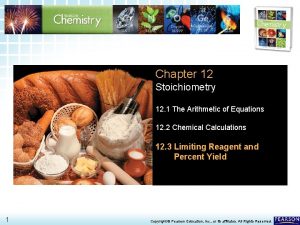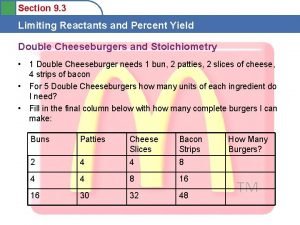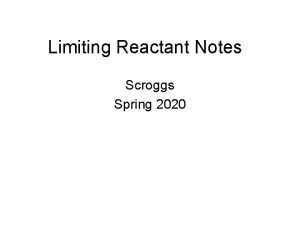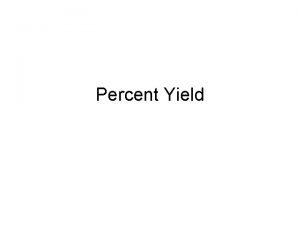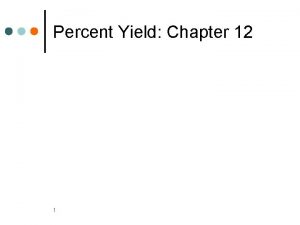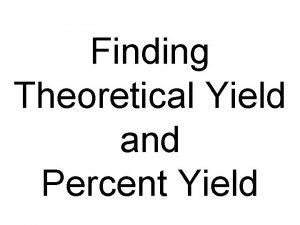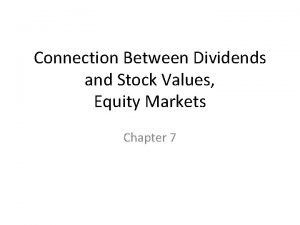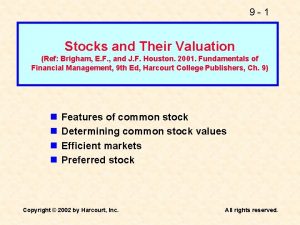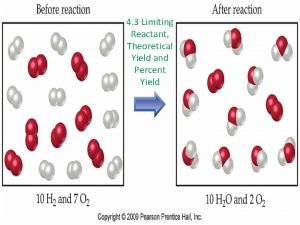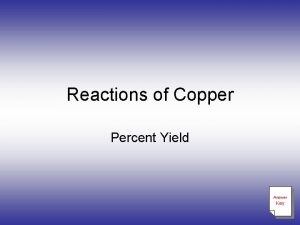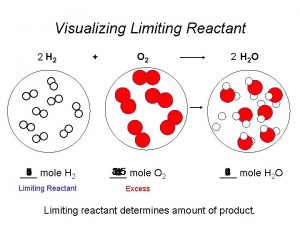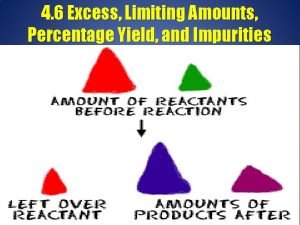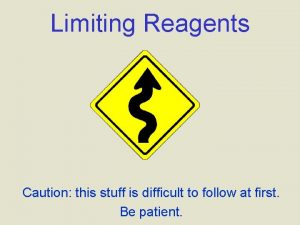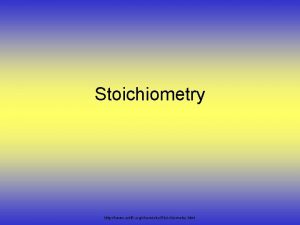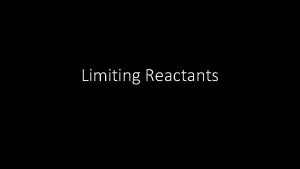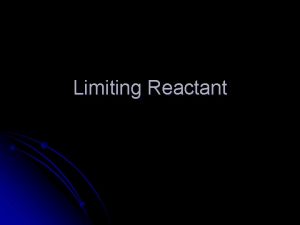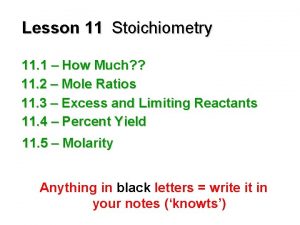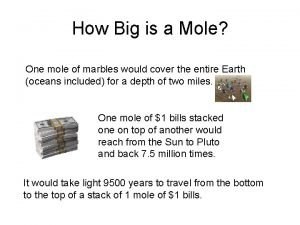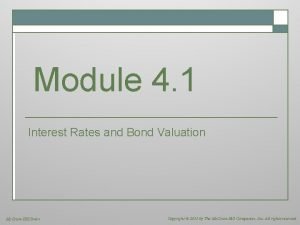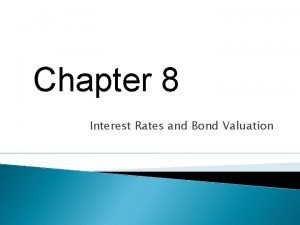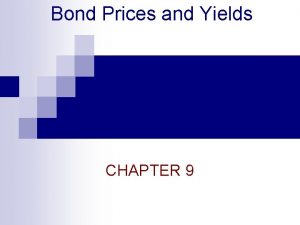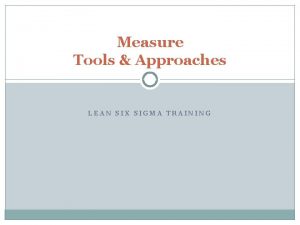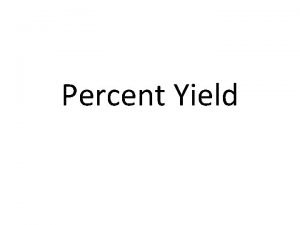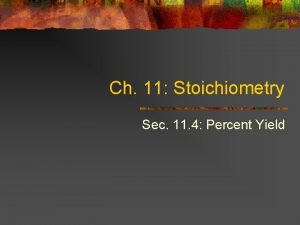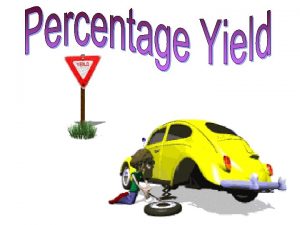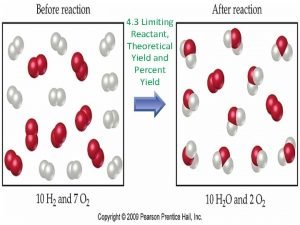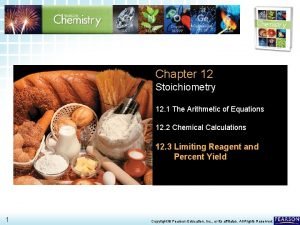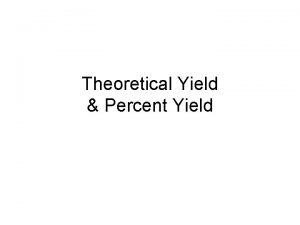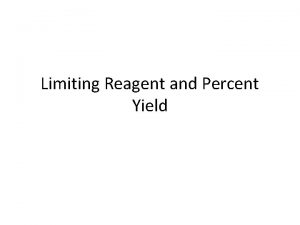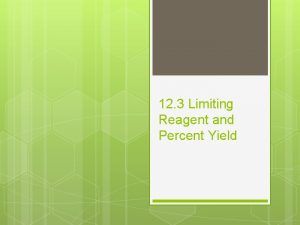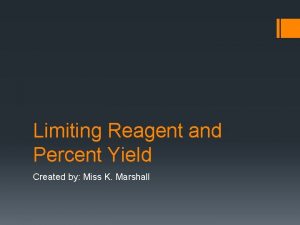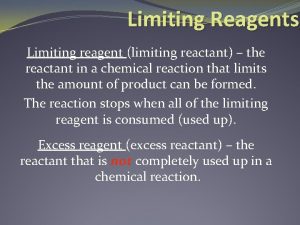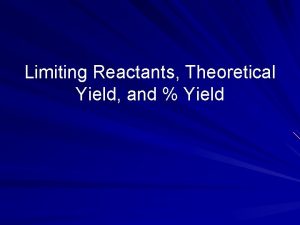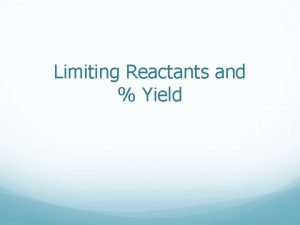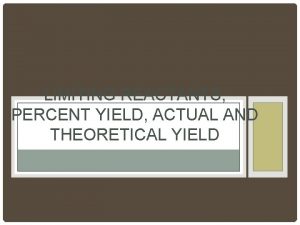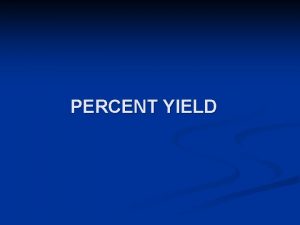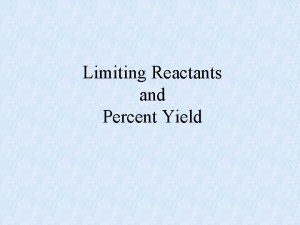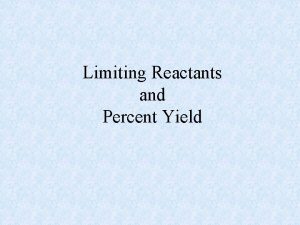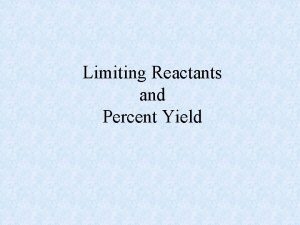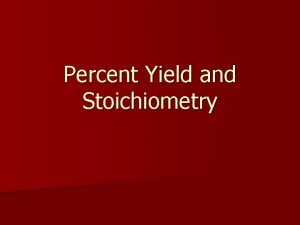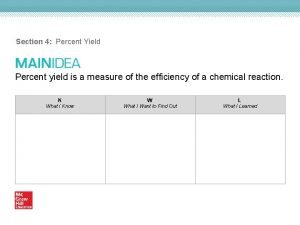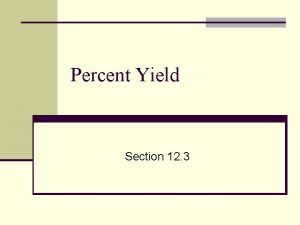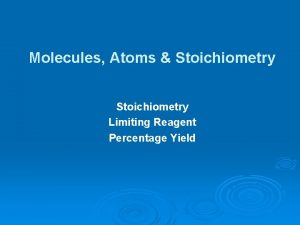Limiting Reagent and Percent Yield 1 Limiting Reagent



































- Slides: 35

Limiting Reagent and Percent Yield 1

Limiting Reagent and Percent Yield • What determines how much product you can make? • If a carpenter had two tabletops and seven table legs, how many functional four-legged tables would he be able to build. ? Why • https: //www. youtube. com/watch? v=ym. CZ 2 S hh. BAw 2

Limiting Reagent and Percent Yield Learning Targets: • I will be able to: 1. identify the limiting reagent in a reaction. 2. calculate theoretical yield, actual yield, or percent yield given appropriate information. 3

Limiting and Excess Reagents • To make tacos, you need enough meat, cheese, lettuce, tomatoes, sour cream, salsa, and seasonings. • If you have only 2 taco shells, the quantity of taco shells will limit the number of tacos you can make. • Thus, the taco shells are the limiting ingredient. 4

Limiting and Excess Reagents • In a chemical reaction, an insufficient quantity of any of the reactants will limit the amount of product that forms. • A balanced chemical equation is a chemist’s recipe. Chemical Equations N 2(g) + 3 H 2(g) 2 NH 3(g) “Microscopic recipe” 1 molecule N 2 + 3 molecules H 2 2 molecules NH 3 “Macroscopic recipe” 1 mol N 2 + 3 mol H 2 2 mol NH 3 5

Limiting and Excess Reagents • What would happen if two molecules (moles) of N 2 reacted with three molecules (moles) of H 2? Experimental Conditions Reactants Products Before reaction 2 molecules N 2 3 molecules H 2 0 molecules NH 3 6

Limiting and Excess Reagents • Before the reaction takes place, N 2 and H 2 are present in a 2: 3 molecule (or mole) ratio. Experimental Conditions Reactants Products Before reaction 2 molecules N 2 3 molecules H 2 0 molecules NH 3 1 molecule N 2 0 molecules H 2 2 molecules NH 3 After reaction • As the reaction takes place, 1 molecule (or mole) of N 2 reacts with 3 molecules (or moles) of H 2 to produce 2 molecules (or moles) of NH 3. 7

Limiting and Excess Reagents • All the H 2 has now been used up, and the reaction stops. Experimental Conditions Reactants Products Before reaction 2 molecules N 2 3 molecules H 2 0 molecules NH 3 1 molecule N 2 0 molecules H 2 2 molecules NH 3 After reaction • One molecule (or mole) of unreacted N 2 is left in addition to the two molecules (or moles) of NH 3 that have been produced by the reaction. 8

Limiting and Excess Reagents • In this reaction, only the hydrogen is completely used up. • H 2 is the limiting reagent, or the reactant that determines the amount of product that can be formed by this reaction. • A limited quantity of any of the reactants that are needed to make a product will limit the amount of product that forms. • limiting reagent: any reactant that is used up first in a chemical reaction • excess reagent: any reactant that remains after the limiting reagent is used up in a chemical reaction 9

• How is the amount of product in a reaction affected by an insufficient quantity of any of the reactants? 10

Determining the Limiting Reagent • Example Problem: • Copper reacts with sulfur to form copper(I) sulfide according to the following balanced equation: 2 Cu(s) + S(s) Cu 2 S(s) • What is the limiting reagent when 80. 0 g Cu reacts with 25. 0 g S? 11

Determining the Limiting Reagent • STEP 1: List the knowns and the unknown. • Knowns Unknown • mass of copper = 80. 0 g Cu limiting reagent = ? • mass of sulfur = 25. 0 g S • molar mass of Cu = 63. 5 g/mol • molar mass of S = 32. 1 g/mol • 1 mol S • 2 mol Cu 12

Determining the Limiting Reagent • STEP 2: Solve for the unknown. • Start with the reactants and convert from mass to moles. 1 mol Cu 80. 0 g Cu 63. 5 g Cu 25. 0 g S = 1. 26 mol Cu 1 mol S 32. 1 g S = 0. 779 mol S 13

Determining the Limiting Reagent • Now, convert moles of Cu to moles of S needed to react with 1. 26 moles of Cu. 1 mol S 1. 26 mol Cu 2 mol Cu = 0. 630 mol S Given quantity Mole ratio Amount of S needed to react w/ the given Cu • Compare the amount of sulfur needed with the given amount of sulfur. 0. 630 mol S < 0. 779 mol S (amount needed to react) • (given amount) Sulfur is in excess, so copper is the limiting reagent. 14

• How would you set up the problem to convert the calculated moles of S to moles of Cu needed to react with 0. 779 mol S? 2 mol Cu 0. 779 mol S x 1 mol S = 1. 558 mol Cu • Given = 1. 26 mol Cu • Needed Amount = 1. 558 mol Cu • Insufficient Cu to react with all the S, Cu is the limiting reagent. 15

Finding the Quantity of Product from the Limiting Reagent • Example Problem: • What is the maximum number of grams of Cu 2 S that can be formed when 80. 0 g Cu reacts with 25. 0 g S? (same quantities from previous problem) • 2 Cu(s) + S(s) Cu 2 S(s) • The limiting reagent, which was determined in the previous sample problem, is used to calculate the maximum amount of Cu 2 S formed. 16

Finding the Quantity of Product from the Limiting Reagent • STEP 1: List the knowns and the unknown. • Knowns Unknown • limiting reagent = 1. 26 mol Cu Yield = ? g Cu 2 S • (from sample problem 12. 8) • 1 mol Cu 2 S = 159. 1 g Cu 2 S • (molar mass) • 1 mol Cu 2 S (mole ratio from balanced equation) • 2 mol Cu

Finding the Quantity of Product from the Limiting Reagent • STEP 2: Solve for the unknown. • Start with the moles of the limiting reagent and convert to moles of the product. Use the mole ratio from the balanced equation. • Finish the calculation by converting from moles to mass of product. 1 mol Cu 2 S 159. 1 g Cu 2 S 1. 26 mol Cu 2 mol Cu 1 mol Cu 2 S = 100 g Cu 2 S 18

Percent Yield • https: //www. youtube. com/watch? v=dodsv. Tfq. WNc • percent yield: the ratio of the actual yield to theoretical yield for a chemical reaction expressed as a percentage • theoretical yield: the amount of product that could form during a reaction calculated from a balanced chemical equation • actual yield: the amount of product that forms when a reaction is carried out in the laboratory 19

Percent Yield • What does the percent yield of a reaction measure? • When a balanced chemical equation is used to calculate the amount of product that will form during a reaction, the calculated value represents theoretical yield. actual yield percent yield = 100% theoretical yield • Because the actual yield of a chemical reaction is often less than theoretical yield, the percent yield is often less than 100%. 20

Percent Yield • The percent yield is a measure of the efficiency of a reaction carried out in the laboratory. The mass of one of the products, the actual yield, is measured. The percent yield is calculated. The mass of the reactant is measured. The reactant is heated. 21

Percent Yield • Many factors cause percent yields to be less than 100%. • Reactions do not always go to completion; when a reaction is incomplete, less than the calculated amount of product is formed. • Impure reactants and competing side reactions may cause unwanted products to form. • Actual yield can be lower than theoretical yield due to a loss of product during filtration or in transferring between containers. • If reactants or products have not been carefully measured, a percent yield of 100% is unlikely. 22

• What is the difference between theoretical yield and actual yield? • What will happen to the percent yield if reactants and products are not measured carefully? • How do we calculate percent yield? 23

Calculating Theoretical Yield • Example Problem: • Calcium carbonate, which is found in seashells, is decomposed by heating. The balanced equation for this reaction is D Ca. CO 3(s) Ca. O(s) + CO 2(g) • What is theoretical yield of Ca. O if 24. 8 g Ca. CO 3 is heated? 24

Calculating Theoretical Yield • STEP 1: List the knowns and the unknown. • Knowns • mass of Ca. CO 3 = 24. 8 g Ca. CO 3 • 1 mol Ca. CO 3 = 100. 1 g Ca. CO 3 (molar mass) • 1 mol Ca. O = 56. 1 g Ca. O (molar mass) • 1 mol Ca. O/1 mol Ca. CO 3 (mole ratio from balanced equation) • Unknown theoretical yield = ? g Ca. O 25

Calculating Theoretical Yield • STEP 2: Solve for the unknown. • Start with the mass of the reactant and convert to moles of the reactant. • Next, convert to moles of the product using the mole ratio. • Finish by converting from moles to mass of the product. 1 mol Ca. CO 3 56. 1 g Ca. O 1 mol Ca. O 24. 8 g Ca. CO 3 1 mol Ca. O 1 mol Ca. CO 3 100. 1 g Ca. CO 3 • = 13. 9 g Ca. O 26

Calculating Percent Yield • Example Problem: • What is the percent yield if 13. 1 g Ca. O is actually produced when 24. 8 g Ca. CO 3 is heated? D Ca. CO 3(s) Ca. O(s) + CO 2(g) Calculate theoretical yield first. Then you can calculate the percent yield. 27

Calculating Percent Yield • STEP 1: List the knowns and the unknown. • Knowns • actual yield = 13. 1 g Ca. O • theoretical yield = 13. 9 g Ca. O (from sample problem 12. 10) actual yield • Unknown =percent yield = theoretical yield 100% 28

Calculating Percent Yield • STEP 2: Solve for the unknown. • Substitute the values for actual yield and theoretical yield into the equation for percent yield. 13. 1 g Ca. O percent yield = 100% = 94. 2% 13. 9 g Ca. O 29

• Carbon tetrachloride, CCl 4, is a solvent that was once used in large amounts in dry cleaning. One reaction that produces carbon tetrachloride is CS 2 + 3 Cl 2 CCl 4 + S 2 Cl 2 • What is the percent yield of CCl 4 if 617 kg is produced from the reaction of 312 kg of CS 2? 30

Calculating Percent Yield • STEP 1: List the knowns and the unknown. • Knowns • 312 kg CS 2 = 312, 000 g CS 2 • actual yield = 617 kg CCl 4 = 617, 000 g CCl 4 • Unknown • theoretical yield = ? • percent yield = ? 31

• STEP 2: Calculate 312, 000 g CS 2 1 mol CS 2 76. 142 g CS 2 1 mol CCl 4 1 mol CS 2 153. 81 g CCl 4 1 mol CCl 4 = 630, 000 g CCl 4 = 630 kg CCl 4 617 kg CCl 4 Percent yield = 100 = 97. 9% 630 kg CCl 4 32

• What is the molar mass of C 4 H 6 O 3? • What is the molar mass of H 2 SO 4? • If starting with 2. 5 moles of butane (C 4 H 10) and 12. 5 moles of oxygen (O 2), what is the limiting reagent? 2 C 4 H 10 + 13 O 2 8 CO 2 + 10 H 2 O 33

Summary of Limiting Reagent & Percent Yield Determining Limiting Reagent • 1) Pick quantity of one reactant (use quantity with a simpler number). • 2) Use mole ratio to determine the needed quantity of other reactant. • 3) Compare needed quantity with actual quantity of 2 nd reactant. Finding the Quantity of Product from the Limiting Reagent • 1) Use given quantity of limiting reagent. • 2) Convert grams to moles of limiting reagent. • 3) Convert moles of limiting reagent to moles of product (using mole ratio). • 4) Convert moles of product to grams of product. 34

Summary of Limiting Reagent & Percent Yield Calculating Theoretical Yield • 1) Convert quantity given in the problem to moles of given. • 2) Convert the moles of given to moles of product. • 3) Convert moles of product to grams of product. Calculating Percent Yield • 1) Determine theoretical yield. • 2) Divide the actual yield by theoretical yield. • 3) Multiply the quotient by 100. 35
 What is theoretical yeild
What is theoretical yeild Limiting reagent and excess reagent
Limiting reagent and excess reagent How to do percent yield
How to do percent yield Limiting reagent
Limiting reagent Dividend yield and capital gains yield
Dividend yield and capital gains yield Difference between actual yield and theoretical yield
Difference between actual yield and theoretical yield Theoretical yeild
Theoretical yeild Calculating percentage yield
Calculating percentage yield Dividend yield and capital gains yield
Dividend yield and capital gains yield Dividend yield and capital gains yield
Dividend yield and capital gains yield Limiting reactant
Limiting reactant Answer key
Answer key What is a limiting reactant
What is a limiting reactant Limiting reagent
Limiting reagent Limiting reactant definition
Limiting reactant definition Limiting reagent
Limiting reagent Limiting reagent shortcut
Limiting reagent shortcut Limiting reactant
Limiting reactant Limiting reagent
Limiting reagent Actual yield def
Actual yield def How to find the limiting reagent
How to find the limiting reagent What is limiting reagent
What is limiting reagent Limiting reactant
Limiting reactant How to calculate valid percent
How to calculate valid percent Current yield vs yield to maturity
Current yield vs yield to maturity Current yield ytm
Current yield ytm Junk bond ratings
Junk bond ratings Rolled throughput yield vs first pass yield
Rolled throughput yield vs first pass yield Percentage yield practice questions
Percentage yield practice questions Percentage yield formula
Percentage yield formula Reactant
Reactant Chapter 11 stoichiometry answer key
Chapter 11 stoichiometry answer key Atom economy vs percent yield
Atom economy vs percent yield What is the percent yield of ferrous sulfide
What is the percent yield of ferrous sulfide Theoretical yield
Theoretical yield Percent yield formula
Percent yield formula

